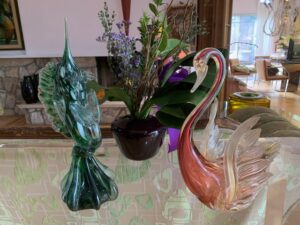 TY sent me a pink blown glass swan, and a green blown glass swordfish, about a foot tall each. The swan is Italian (Murano), the swordfish is Mexican “end of day” glass. “End of day” is the glass left over after a glass blower does the day’s work in colors, and the mixture of colors of left over glass in the swordfish piece gives that “end of day quality” away. Not worth much.
TY sent me a pink blown glass swan, and a green blown glass swordfish, about a foot tall each. The swan is Italian (Murano), the swordfish is Mexican “end of day” glass. “End of day” is the glass left over after a glass blower does the day’s work in colors, and the mixture of colors of left over glass in the swordfish piece gives that “end of day quality” away. Not worth much.
I want to focus on the swan, as it has symbolized the material world in many cultures for ages. In fact my grandmother from Hamburg, Germany, kept a small collection of glass swans in her NY home. She remembered them on the Alster River in 1910-1920s.
Any ‘passage’ creature, partaking of two elements (snake: earth and air and water, swan: earth and air and water), comes with meaning. In the Hindu culture the swan sucks the milk out of a milk-water mix (earth and water). A swan’s plumage of pure white is the closest creature to the world soul.
Huge Male
The swan, especially the male, appears huge with a wing span of up to six feet and weighing thirty pounds. When one flies, it exemplifies the release from the cycle of birth and death (samsara), because when a swan flies, it’s a mighty thing to see.
Let’s not forget the sexual symbolism of the swan due to both the size of the male and the length and aggressive nature of the neck and beak. In the arguably most sexualized era of France, the Second Empire, sex was rampant but never discussed—and remained undercover in 1870-1890. Consider the famous sculpture “Leda and the Swan,” after the myth of Leda and Zeus. Zeus desired the low born maiden Leda, and he devised a way to NOT be an aggressive human male but a beautiful animal male swan. Sculptor Carrier-Belleuse created the maquette, the terracotta prototype at the MET, in 1870 and reproduced it in the thousands.
My grandmother came from Hamburg, the city of the Alster Swans, but my grandfather came from Leipzig, the area known for porcelain in the 18th century. I visited the Meissen Museum there looking for the famous Meissen Swan Service. Hard to believe, but before the 18th century, Europe didn’t know how to make or fire porcelain. They discovered the recipe in the early 18th century in Meissen/Dresden area of Germany. The most famous of all porcelain artists of the time was Johann Joachim Kaendler. He created ‘dinner party tableware sets,’ the 2200 piece (1737-42) Swan service for a Polish nobleman named Henrich von Bruhl, director of the Meissen Porcelain works in the early 18th century.
Why a Swan service?
The name ‘Bruhl’ in German refers to a swamp, and swans are creatures of earth, water and air, as are swamplands. If nothing else, the 18th century was a time of allegory. Kaendler knew this and visited the Dresden Natural History Museum to sketch the swan.
Only a few pieces of the Swan Service remain today. It depicted two beautiful relief swans in ‘white on white’ porcelain on each dinner plate, cup, and tureen, platter, and candelabra and sconce. At the end of WWII the Red Soviet army invaded Poland, and found the service in the basement of the Bruhl Castle. They used the pieces for target practice.
Swans in material culture are symbols that still live. Insult a Hamburg swan by yelling, and under a 17th century law you will receive a fine. To harm a Hamburg swan you harm Hamburg’s right to freedom and prosperity. A ‘Swan Father’ who has been in charge of Hamburg swans for 20 years, or his father, in charge for 46 years, will go for you in true German fashion.
The Myth
When the world is good, the swans will come, and during the French Siege of Hamburg in 1813, only two swans existed, and after 1919 sixteen swans survived. Today there are 120, of which the eldest is twenty-four years-old.
The legendry midcentury artist Seguso created this Murano Glass Swan worth $800.